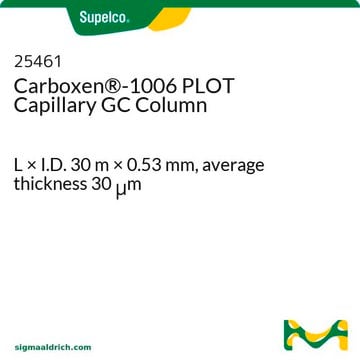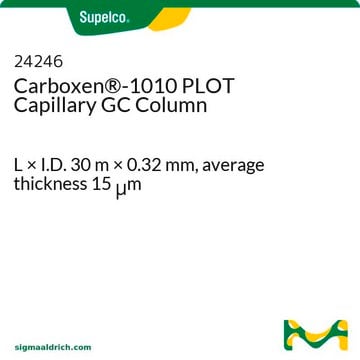25467
Carboxen®-1010 PLOT Capillary GC Column
L × I.D. 30 m × 0.53 mm, average thickness 30 μm
Synonim(y):
Carboxen® 1010 PLOT Column, 30m x 0.53mm
About This Item
Polecane produkty
Materiały
fused silica
agency
ASTM® D3612-96
opis
PLOT = Porous Layer Open Tubular
producent / nazwa handlowa
Carboxen®
Parametry
≤25-250 °C temperature (isothermal or programmed)
średnia grubość
30 μm
df
30 μm
metody
gas chromatography (GC): suitable
dł. × śr. wewn.
30 m × 0.53 mm
grupa aktywna macierzy
Carbon molecular sieve phase
Zastosowanie
chemicals and industrial polymers
food and beverages
typ kolumny
capillary PLOT
Szukasz podobnych produktów? Odwiedź Przewodnik dotyczący porównywania produktów
Opis ogólny
USP Code: None
Phase:
- Carbon molecular sieve
- Subambient to 250 °C (isothermal or programmed)
Inne uwagi
Informacje prawne
Zastosowanie
Choose from one of the most recent versions:
Masz już ten produkt?
Dokumenty związane z niedawno zakupionymi produktami zostały zamieszczone w Bibliotece dokumentów.
Klienci oglądali również te produkty
Protokoły
Oddzielenie wartości zerowej
Chromatograms
suitable for GCNasz zespół naukowców ma doświadczenie we wszystkich obszarach badań, w tym w naukach przyrodniczych, materiałoznawstwie, syntezie chemicznej, chromatografii, analityce i wielu innych dziedzinach.
Skontaktuj się z zespołem ds. pomocy technicznej


